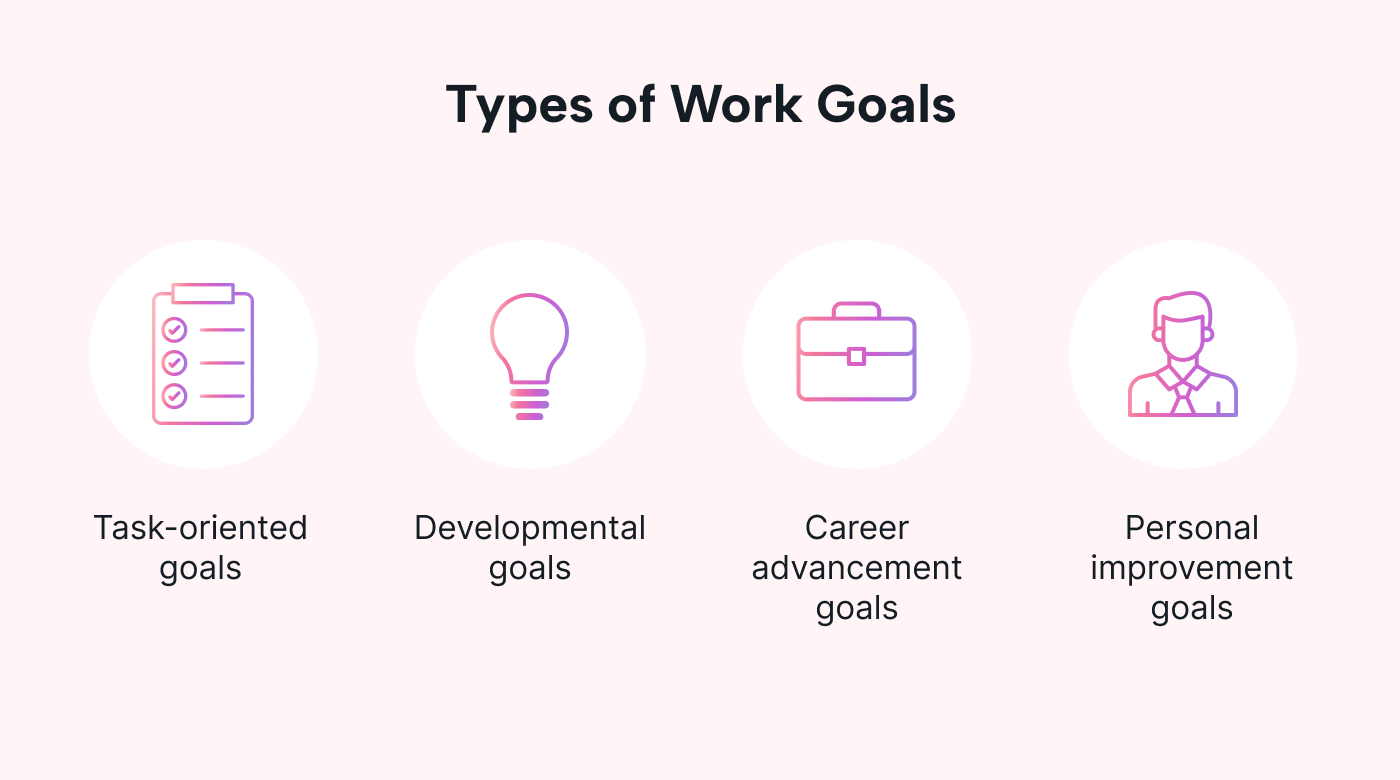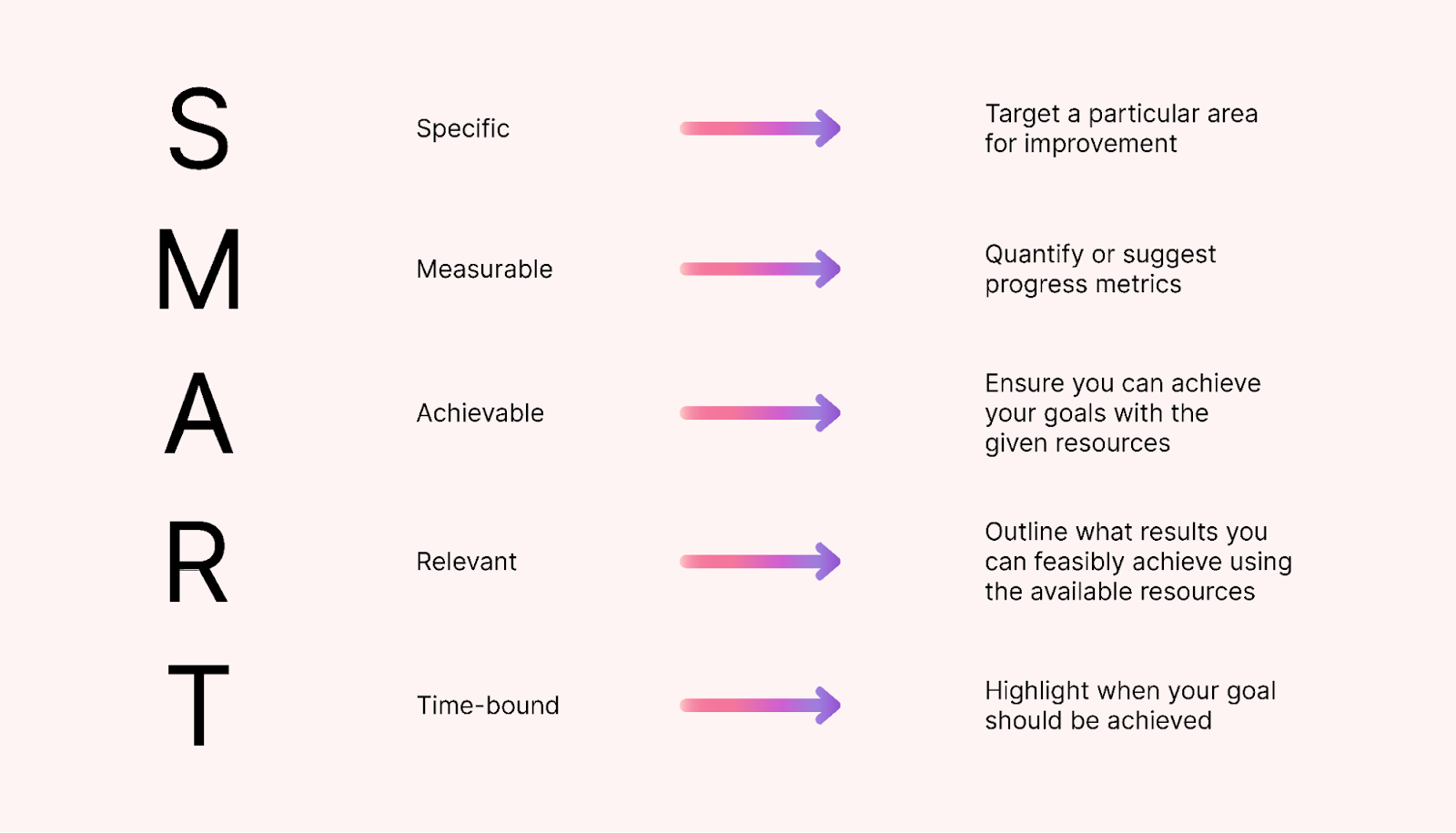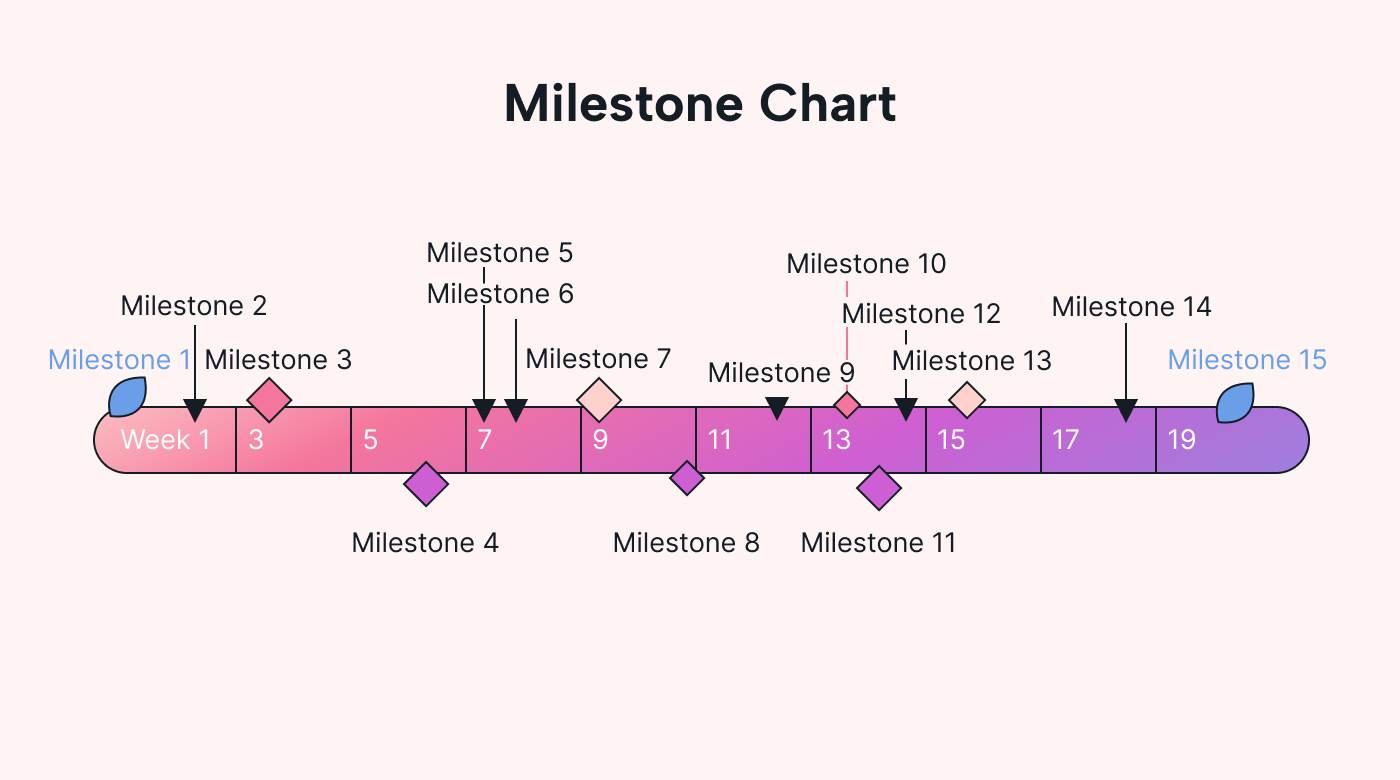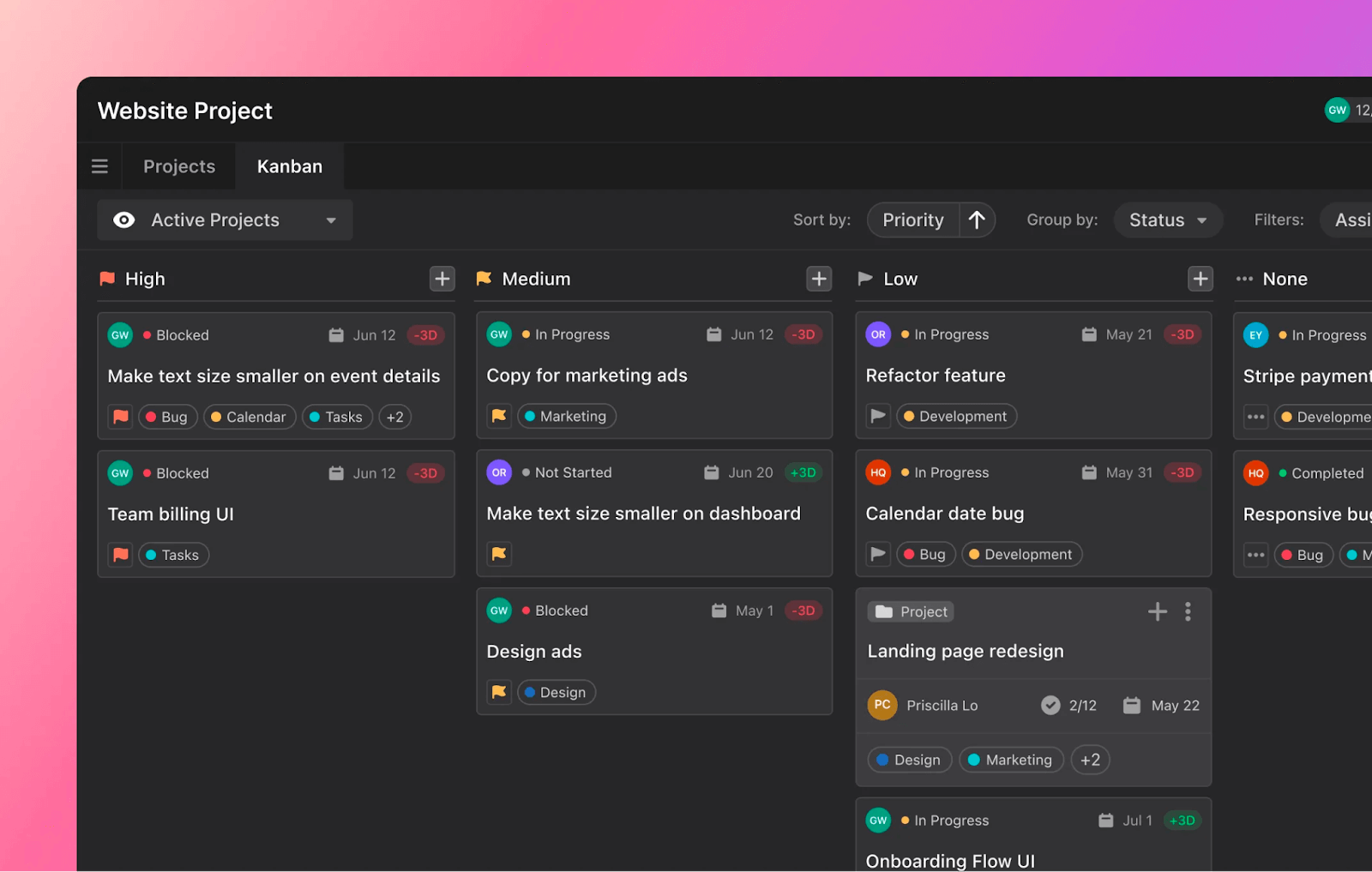Running a business can feel like you’re trying to build a plane while flying it.
You’re managing tasks, herding teams, juggling priorities, and fighting fires all at once.
It can feel impossible to take a moment out of the mayhem to set goals with your team.
Here’s the problem: Without a clear, unified direction, even the most talented teams flounder. You’ll waste time, effort, and resources on things that don’t make an impact.
You need a simple, streamlined process to set effective goals to keep your team engaged and on task.
This article offers practical steps, tips, and insights on setting goals and achieving them.
What's team goal-setting?
Team goal-setting is a collaborative process. Your group comes together to craft targets that help you meet business objectives.
Its coordinated approach strengthens teamwork and communication. Team collaboration brings together diverse skills and ideas. By combining perspectives, you can come up with more efficient and innovative goals.
Then, with team goals in place, you coordinate individual efforts so everyone focuses on the team's overarching aim. This way, everyone’s rowing in the same direction.
By coming together, your team can each give feedback on what’s affecting their ability to convert, say, prospects into sales. This way, you can collectively identify the main areas of concern to help narrow down your focus.
For instance, take a sales team with declining conversion rates.
Some team members complained about slow online sales processes or managerial bottlenecks. But most highlight scheduling issues: Double-booked sales calls, lack of senior staff availability, and sales calls schedule overruns.
Now, the team can focus on setting a goal that targets the most prominent issue:
We'll fully integrate AI scheduling software over the next three months to improve conversion rates by 10% over the next 12 months.
But remember, a goal can tackle more than one objective at once.
Let’s say the sales team is also experiencing high staff turnover due to burnout. No wonder: Schedules are hectic, and everyone’s working lots of overtime without seeing results.
In this case, the goal would incorporate both objectives:
We'll fully integrate AI scheduling software over the next three months to improve conversion rates by 10% and reduce turnover by 30% over the next 12 months.
How's it different from setting individual goals?
Individual or personal goals center around personal task management, development, and self-improvement. Team goals, on the other hand, are often operational or project-specific goals.
Team goals cast a wider net.
When teams work together on goals, they can take a big-picture view. By overlapping skills and perspectives from each role, teams can create goals that work toward wider strategic objectives.
This means that success also looks different. You plan your goal outcomes based on whole-team success, rather than the success of one person or process.
Why set team goals? Who reaps the benefits?
Effective team goals harness and benefit the entire team. It’s about everyone figuring out how to achieve their objectives together. You align individual strengths toward a shared goal.
Your team works together to reach targets
Shared thinking has the biggest effect on team performance, according to CIPD. A collaborative approach shifts focus from isolated tasks to team efforts.
To meet team objectives, you collaborate on actionable goals shaped by team experience and skills.
When a team feels aligned toward a common goal, it’s easier to coordinate their time, resources, and skills. This way, everyone’s input works toward a unified outcome rather than scattered, individual-level results.
Your team finds creative solutions
When teams share a vision, they pool ideas, skills, and experience. This fosters an innovative environment.
As a recent CIPD report puts it, “When people work well together towards a common goal, they often go above and beyond their individual responsibilities to achieve great things.”
Bringing ideas and viewpoints together allows you to envision new solutions you might not have thought of alone. Two heads are better than one, as they say. But it’s not just about setting the goal as a team.
Collaborative efforts help teams identify potential roadblocks and define and achieve important metrics and milestones.
These varied viewpoints introduce factors that help you and your team set realistic goals that consider risks and challenges. This increases your chances of success.
Your team feels engaged and invested
Team goal-setting creates an environment where everyone’s voice counts — at a time when 31% of recently resigned workers said they left their jobs due to a lack of meaningful work.
Since everyone contributes to the decision-making process, accountability and ownership flourish. Working as a team helps members feel engaged and invested in a common goal.
This doesn’t just boost employee morale. Team members also feel empowered to share ideas to evolve your business.
You reach targets more efficiently
With your team working together like a well-choreographed dance, efficiency soars.
Not only are they able to craft achievable goals, but they also quickly learn how to put them into practice as a unit. Everyone learns to communicate and collaborate better so workflows feel smoother.
This not only speeds up work, but also leads to higher-quality outputs with fewer delays or mistakes.
How to set team goals in 6 steps
Step 1: Lay out exactly what you want to achieve
For your goals to be reachable, they need to be specific and measurable. This way, you know exactly what you’re headed for, and you can keep tabs on your progress.
They should also be relevant to the progress you want to make in your overall business. It’s no good focusing on growth goals if you’re churning customers like there’s no tomorrow.
Use your whole team to help you create SMART goals. By combining diverse knowledge, you’ll create more realistic goals based on ‘boots-on-the-ground’ experience.
- Specific: You’re explicit about what you’ll achieve (for example, “10% more” instead of just “better”)
- Measurable: You can quantify your progress (improve customer satisfaction scores on surveys from 76% to 90% within 12 months, instead of “better customer satisfaction scores”)
- Achievable: You’re aiming for improvements or benchmarks you can actually meet (“convert 100% of leads into sales” is a nice goal but not realistic)
- Relevant: You’re not trying for something that isn’t in your wheelhouse (the sales department shouldn’t make goals about product development)
- Time-bound: You’ll achieve it by a certain deadline (instead of leaving the time frame open-ended)
So SMART team goals might look like…
- We'll launch a (specific) trend-driven product line by the end of next quarter.
- We'll onboard 15 new clients over the next 6 months.
- We’ll halve our average project completion time within the next year.
Step 2: Listen to everyone’s input
Encourage each team member to contribute. It’s not just so every team member feels valued and heard. Leveraging diverse viewpoints helps you create more resilient, meaningful goals.
To help teams express their perspectives, set aside time for training. Teach teams how to listen to ideas and set goals as a group. By preparing team members in advance, you foster an environment of active participation. Teams learn to coordinate better to synchronize ideas.
Step 3: Set target dates and milestones
It’s hard to achieve major goals all at once. Breaking them down into smaller activities or tasks can not only make them seem more achievable, they actually will help you measure and achieve the smaller steps on the way to the larger goal.
Grouping the smaller tasks into milestones will help your team focus,and will give them something to celebrate along the way. Teams that define their own milestones can focus on them and take responsibility for achieving them. With ownership comes accountability.
Try creating a milestone chart to outline key results or deliverables and dates.
Step 4: Assign team members to actionable tasks
Allocate specific tasks to team members. Align each person’s role with their strengths and interests.
Make sure you have a defined system to allocate tasks. If you want your team to be accountable, they need to know exactly what they should be doing at each stage.
Try creating a responsibility matrix to define each team member’s specific role.
Allocate and schedule tasks with a tool like Motion so you can track and manage everyone’s assignments in one place.
Step 5: Track progress regularly
Monitor goal progress consistently. By keeping track, you can check if your team's actions align with your roadmap.
You can also identify which actions work and which don’t work. By checking regularly, you can course-correct as you go. Otherwise, you’ll get to the end of your roadmap, having missed several deadlines, and realize you’d chosen the wrong strategy all along.
Step 6: Celebrate achievements
Recognize and celebrate milestones to keep your team motivated. Celebrating successes underscores the importance of teamwork and inspires everyone to keep up the collective effort.
Say you’ve reached a big milestone or the team has exceeded expectations. Take everyone out for lunch. On a smaller scale, you could share your accomplishments on LinkedIn or in your company-wide newsletter. And, of course, remember to provide individual recognition, too.
Tips for successful goal setting: dos and don’ts
Effective business goals supercharge team performance.
Here are some essential tips to help you set successful team goals to drive high-performing teams.
Combine your efforts
Harness diverse team strengths to tackle multiple objectives at once.
Let’s say you set a goal to launch four new product lines this year. That’s a big initiative.
This goal not only diversifies your product range. It also expands market reach, generates extra revenue streams, and enhances your competitive advantage.
It’s a multi-pronged attack to maximize business success. Use all the skills of your team to solve lots of problems through one well-coordinated focus.
Be mindful of team resources
Don’t overcommit your time and resources to unrealistic goals.
For instance, you can use AI to optimize team schedules to make the most of everyone’s time without overburdening anyone.
Understand the resources you have and optimize (not maximize) their usage. This is the key to preventing burnout.
Create space for team input
Team goal-setting demands everyone’s input. But for this to work, you need to create an environment where every member feels comfortable sharing ideas.
Organize team training sessions focused on idea generation and sharing. Show teams how to give quieter team members space to voice their thoughts.
Let software take care of task management
Use AI to intelligently schedule tasks.
Motion makes it easy for teams to focus on executing tasks rather than wasting time on scheduling and admin. Or figuring out what to do next.
Not only do you cut back on menial scheduling tasks, Motion optimizes team schedules — not just applying a template — so everyone makes the best use of their time.
Be prepared for change
Goals need to be flexible.
All businesses experience unforeseen challenges or priority shifts. You need processes that make it easy to revisit your goals and tweak them if necessary.
For example, imagine a branding agency. It aims to finish a complete client rebrand before the launch of a new product in six months’ time. The client moves the product launch up. Now, it needs to finish the rebrand in three months.
As the agency is open to modifying goals as challenges arise, it can change tasks to accommodate these shifting aims.
Communicate clearly and often
Open, frequent communication is crucial in the goal-setting process.
Regular updates keep everyone on the same page. But be mindful of overwhelming your team.
While they need continuous dialog, team members should receive personalized updates so they’re not inundated with irrelevant information.
Tools like Motion send personalized updates automatically so relevant team members stay informed on progress and changes.
Reach your goals faster with Motion
Team goal-setting helps your business grow and operate more efficiently. A united team that shares the same objectives can use their diverse skills to reach goals together.
But, even with the best-laid plans, it can be hard to keep everything on track. Achieving your goals requires you to align resources and manage tasks every step of the way.
Motion can help with that. It uses AI to help you plan your optimal work days (and non-work if you want it to). It intelligently schedules your whole team and shifts schedules when plans change.
It synchronizes team efforts and optimally schedules resources while keeping the relevant people in the loop. This way, you and your team meet all milestones in the most efficient way. You reach goals faster without feeling tangled up in tasks.
Want to see how? Try Motion and feel the difference.









